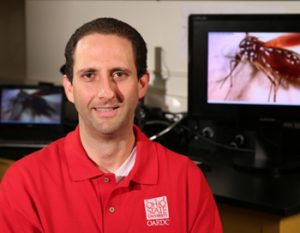The spotted wing drosophila is a tiny non-native fly, about two pinheads in size, resembling the common vinegar fly, that’s a big growing pain for small fruit.

Continue reading Using netting against spotted wing drosophila
The spotted wing drosophila is a tiny non-native fly, about two pinheads in size, resembling the common vinegar fly, that’s a big growing pain for small fruit.

Continue reading Using netting against spotted wing drosophila
CFAES’s Ohio Woodland Stewards Program presents Common and Uncommon Woodland Pests from 9 a.m. to 3 p.m. Aug. 17 at Ohio State’s Mansfield campus. It’s a workshop on two kinds of forest bugs and diseases: ones you probably don’t have to worry about, and ones you do. It’s all aimed at helping you keep your trees healthy.

Registration is $35, includes lunch and materials, and is needed by Aug. 10.
Get details. (Photo: Gypsy moth larva, one of the latter kind of buggers, by John Ghent, Bugwood.org.)
 It’s not often that a grower comes across a piece of new equipment that can give a full return on investment in one year and can reduce their farm’s impact on the environment.
It’s not often that a grower comes across a piece of new equipment that can give a full return on investment in one year and can reduce their farm’s impact on the environment.
But a device made by researchers from CFAES and from the U.S. Department of Agriculture is promising just that.
The team’s “intelligent” pesticide sprayer is the first automatic spraying system of its kind in the world.
 “We’re taking advantage of something plants have been doing for millions of years” — evolving chemicals to defend themselves from pests — “to hopefully get a leg up on mosquitoes.”
“We’re taking advantage of something plants have been doing for millions of years” — evolving chemicals to defend themselves from pests — “to hopefully get a leg up on mosquitoes.”
So says CFAES scientist Pete Piermarini, pictured, explaining a recent study. In it, he and scientist Liva Rakotondraibe of Ohio State’s College of Pharmacy discovered a possible new mosquito-fighting chemical in a plant from Madagascar.
Read the full story. (Photo: Ken Chamberlain, CFAES.)
 Ohio State scientists, including from CFAES, have successfully tested a new chemical to control mosquitoes, including the ones that spread Zika, and it comes from a traditional medicinal plant found only in Madagascar.
Ohio State scientists, including from CFAES, have successfully tested a new chemical to control mosquitoes, including the ones that spread Zika, and it comes from a traditional medicinal plant found only in Madagascar.
Read the story. (Photo: Zika’s main carrier, the Aedes aegypti mosquito, iStock.)
 If you spent this past winter finding multicolored Asian lady beetles on your lampshades, brown marmorated stink bugs on your toaster, there’s bad news and good news.
If you spent this past winter finding multicolored Asian lady beetles on your lampshades, brown marmorated stink bugs on your toaster, there’s bad news and good news.
 What’s in bloom in your town? Use CFAES’s online Phenology Calendar to find out. Go to the website, enter your ZIP code, and see a daily listing of the stages of bloom of trees and shrubs around you. Entries might say, “Apple serviceberry, first bloom,” for example, or “Koreanspice viburnum, full bloom.” There’s also an option to see the whole season.
What’s in bloom in your town? Use CFAES’s online Phenology Calendar to find out. Go to the website, enter your ZIP code, and see a daily listing of the stages of bloom of trees and shrubs around you. Entries might say, “Apple serviceberry, first bloom,” for example, or “Koreanspice viburnum, full bloom.” There’s also an option to see the whole season.
 John Cardina, professor in CFAES’s Department of Horticulture and Crop Science, along with collaborating faculty in the Office of International Programs in Agriculture and four other departments in the college, have been awarded a major Integrated Pest Management (IPM) Innovation Lab project titled “Vegetable Crops for East Africa.” Continue reading Ohio State tapped to lead major IPM project in East Africa
John Cardina, professor in CFAES’s Department of Horticulture and Crop Science, along with collaborating faculty in the Office of International Programs in Agriculture and four other departments in the college, have been awarded a major Integrated Pest Management (IPM) Innovation Lab project titled “Vegetable Crops for East Africa.” Continue reading Ohio State tapped to lead major IPM project in East Africa
It’s spring, or almost spring, and stink bugs are on the move again — often inside your home. Want to get rid of them? Read this previous post, then watch the super-short video it links to.
 Check spring’s progress using CFAES’s online Growing Degree Day Phenological Calendar. Enter your ZIP code and track the latest status of plant and insect development in your area, all based on how warm (or not) it’s been. The idea behind it: Knowing when key pests are present and vulnerable allows farmers, gardeners and other plant people to spray less pesticide, a boost to economic and environmental sustainability.
Check spring’s progress using CFAES’s online Growing Degree Day Phenological Calendar. Enter your ZIP code and track the latest status of plant and insect development in your area, all based on how warm (or not) it’s been. The idea behind it: Knowing when key pests are present and vulnerable allows farmers, gardeners and other plant people to spray less pesticide, a boost to economic and environmental sustainability.